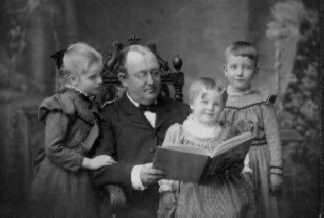
Dresses for Boys during the Late-19th Century: Personal Experiences

Figure 1.--I estimate that this American family scene of a father reading to his children was taken during the 1890s. The child on the right is a boy. He looks to be wearing
'a dress, but it could be a smock. I do not know about the younger child. Note small bows in the child's hair.
|
Some details are available on the actual experiences of several late 19th century boys who wore dresses. Most are the children of notable indivisuals of the day as they were the most likely to gave written about their childhood or have their childhood touch upon in books about their familiy experiences.
English watercoloist Helen Allingham was born near Burton on Trent.
Her family settling in Birmingham, after the untimely death of her father in 1862. Allingham studied art at the Birmingham School of Design. She is widely recognized as an important English watercolor painter of the late 19th and early 20th Centuries. Most of her work is exteriors, but a few are of her children, often in formal clothes. This provides a rare insight into play clothes in the late 19th Century as most of the available portraits and photographs show the children in their dress party clothes.
The Vicomte de Lesseps was one of the most famous Frencmen of the mid-19th Century because of his role in building the
Suez Canal. He was not an engineer, but a great promoyer. Even the failure of his Panama project and resulting finanacial crisis
in his old age did not totally elclipse his great success at Suez. I am not sure how he was dressed as a boy, but the clothes wore
by his profigious family provide a glimse of Fremch boyhood fashions in the late 19th Century.
Famed French journalist Emile Zola had two children. The girl, Dennis, was born in 1889 and her younger brother, Jacques, was born 2 years later in 1891. The children often played together as
they were schooled at home and did not mix with a lot of other children. One of the things some authors have noted was the isolation of French children until they were quite old. School was the
first time many French children played with other children. Even in the country during the summers some children were mostly around adults. French families seem to have been very close knit units. This was especially true of the Zola family. Jack and Dennis' best friend seems to have been each other. They only occasionally played with other
children when friends visited. They may have been more isolated, however, because their mother was Zola's mistress.
An interesting book provides some fascinating details on French boyhood during the 1890s-1900s. It offers insights on several
different topics, clothes, hair styles, and school life. It is the memories of Paul Vailland-Couturier who was born in 1893. The
book was translated from the French by Ida Treat, an American paleontologist and journalist. I've included some text about his
clothes at 4 years of age and about his first experiences in school. Included also are some sketchesof Paul at about 7. Compare
the information in the text with the photographs available for Emile Zola's son Jacques, a contemporary of Paul. The sailor suit
with knickers worn by Paul are similar to the ones worn by Jacques who also wore curls and latter bangs. One of the things
emphasized in this book is the isolation of French children until they were quite old. School was the first time Paul played with
other children. Even in the country in the summers he was mostly around adults. French families seem to have been very close
knit units.
The French impressionist painter Pierre Auguste Renoir (1841-1919) is one of the most prominent artists of our era. He was born in Limoges in a humble family. I'm not sure how he was dressed as a boy and do not yet have details on his boyhood. His children were among his favorite subjects and thus a great deal of information is available on thee children and how they were dressed.
Christopher Wagner

Navigate the Historic Boys' Clothing Web chronological pages:
[The 16th century]
[The 17th century]
[The 18th century]
[Mid-18th century]
[Late-18th century]
[The 1800s]
[The 1810s]
[The 1820s]
[The 1830s]
[The 1840s]
[The 1850s]
[The 1860s]
[The 1870s]
[The 1880s]
Navigate the Historic Boys' Clothing Web dress pages:
[Return to the Main dress page]
[Return to the Main late 19th century page]
[Pinafores]
[Sausage curls]
[Smocks]
[Bodice kilts]
[Kilts]
[Fauntleroy dresses]
[Sailor dresses]
[Fancy dresses]
[Dresses: 17th century]
[Dresses: 18th century]
[Dresses: Early-Mid-19th century]
[Dresses: Early 20th century]
[Difficult images]
[Movie dresses]
Navigate the Boys' Historical Clothing Web Site:
[Introduction]
[Activities]
[Bibliographies]
[Biographies]
[Chronology]
[Clothing styles]
[Countries]
[Contributions]
[Hair]
[Boys' Clothing Home]
Created: November 30, 1998
Last updated: December 4, 2000



